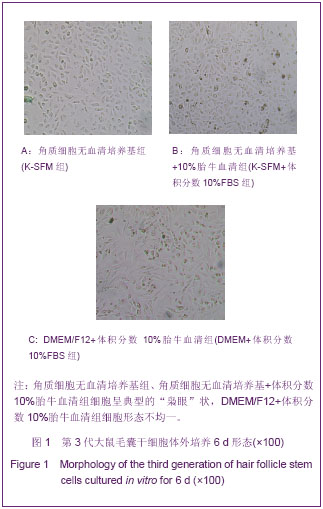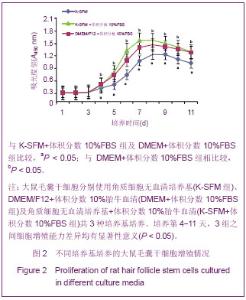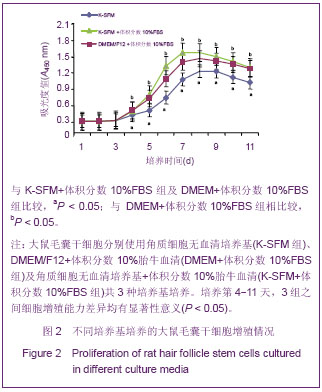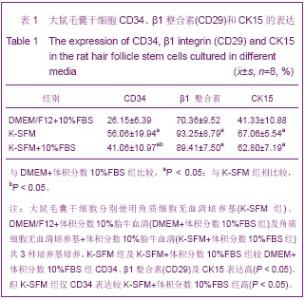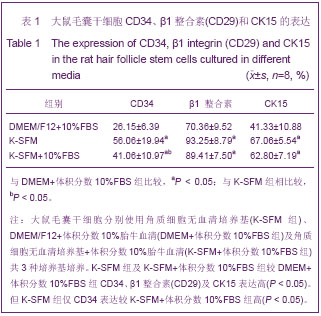| [1] Basu J, Mihalko KL, Payne R,et al. Extension of bladder-based organ regeneration platform for tissue engineering of esophagus. Med Hypotheses. 2012;78(2): 231-234.
[2] Jaks V, Kasper M, Toftgard R, et al. The hair follicle-a stem cell zoo. Exp Cell Res. 2010;316(8):1422-1428.
[3] Hoffman RM. The pluripotency of hair follicle stem cells. Cell Cycle. 2006;5(3):232-233.
[4] Duong J, Mii S, Uchugonova A, et al. Real-time confocal imaging of trafficking of nestin-expressing multipotent stem cells in mouse whiskers in long-term 3-D histoculture. In Vitro Cell Dev Biol Anim. 2012;48(5):301-305.
[5] 许志成,李宏,张群等.体外诱导毛囊干细胞成血管平滑肌细胞的实验研究[J].组织工程与重建外科杂志,2012,8(4):181-184.
[6] Drewa T, Joachimiak R, Bajek A, et al. Hair follicle stem cells can be driven into a urothelial-like phenotype:An experimental study. Int J Urol. 2013;20(5):537-542.
[7] Loureiro RR, Cristovam PC, Martins CM, et al. Comparison of culturemedia for exvivocultivation of limbal epithelial progenitor cells. Mol Vis. 2013;19:69-77.
[8] Kobayashi T, Shimizu A, Nishifuji K, et al. Caninehair- folliclekeratinocytesenriched with bulge cells have the highly proliferative characteristic of stem cells. Vet Dermatol. 2009; 20(5-6):338-346.
[9] 柯锦城,程波.毛囊干细胞对坐骨神经损伤修复的影响[J].中国组织工程研究,2012,(32):5978-5982.
[10] 杨青,李秀兰,张杨,等.表皮干细胞与毛囊干细胞生物学特性的比较[J].中国组织工程研究,2012,16(27):5034-5038.
[11] 华云旗,李秀兰,张杨,等.毛囊干细胞的分离及培养方法研究[J].国际生物医学工程杂志,2007,30(3):133-137.
[12] 符刚,高强国,杨恬,等.无血清K-SFM培养条件下大鼠毛囊Bulge细胞生物学特性的研究[J].第三军医大学学报,2005,27(15): 1538-1540.
[13] The Ministry of Science and Technology of the People’s Republic of China. Guidance Suggestions for the Care and Use of Laboratory Animals. 2006-09-30.
[14] 王祝迁,木拉提•热夏提,李佳,等.大鼠触须毛囊干细胞的分离培养和鉴定[J].中国组织工程研究与临床康复,2011,27(15): 5031-5034.
[15] Jahoda CA, Whitehouse J, Reynolds AJ, et al. Hair follicle dermal cells differentiate into adipogenic and osteogenic lineages. Exp Dermatol. 2003;12(6):849-859.
[16] Liu JY, Peng HF, Gopinath S, et al. Derivationof functional smooth muscle cells from multipotent humanhair follicle mesenchymal stem cells. Tissue Engineering Part A. 2010; 16(8):2553-2564.
[17] Drewa T. Using hair-follicle stem cells for urinarybladder-wall regeneration. Regen Med. 2008;3(6):939-944.
[18] 彭文标,刘春晓,谢群,等.富集兔毛囊干细胞构建组织工程化尿道的研究[J].上海交通大学学报:医学版,2013,33(3):285-289.
[19] 夏汝山,郝飞,杨希川,等.无血清培养基培养人毛乳头细胞的研究[J].中华皮肤科杂志,2006,39(6):335-337.
[20] 史明艳,林峰,杨学义,等.不同浓度的EGF对山羊毛囊干细胞体外培养的影响[J].西北农业学报,2009,18(3):26-28.
[21] Liu ZZ, Chen P, Lu ZD, et al. Enrichment of breast cancerstem cells using a keratinocyte serum-free medium. Chin Med J (Engl). 2011;124(18):2934-2936.
[22] 辛国华,曾元临,邱泽亮,等.有血清和无血清培养人表皮干细胞的比较研究[J].中华烧伤杂志,2007,23(2):139-140.
[23] 木拉提•热夏提,彭彧,李佳,等.毛囊干细胞与异种膀胱脱细胞基质生物相容性的研究[J].中华泌尿外科杂志,2013,34(5):384- 388.
[24] Hasebe Y, Hasegawa S, Hashimoto N, et al. Analysis of cellcharacterization using cellsurfacemarkers in the dermis. J Dermatol Sci. 2011;62(2):98-106.
[25] Yang L, Peng R. Unveiling hair follicle stem cells. Stem Cell Rev. 2010;6(4):658-664.
[26] Oh JH, Mohebi P, Farkas DL, et al. Towards expansion of human hair follicle stem cells in vitro. Cell Prolif. 2011;44(3): 244-253.
[27] Ma DR, Yang EN, Lee ST. A review: the location, molecular characterisation and multipotency of hair follicle epidermal stem cells. Ann Acad Med Singapore. 2004;33(6):784-788.
[28] Raposio E, Guida C, Baldelli I, et al. Characterization of multipotent cells from human adult hair follicles. Toxicol In Vitro. 2007;21(2):320-323.
[29] Zhang Y, Xiang M, Wang Y, et al. Bulgecells of humanhairfollicles: segregation, cultivation and properties. Colloids Surf B Biointerfaces. 2006;47(1):50-66.
[30] Hoang MP, Keady M, Mahalingam M. Stem cell markers (cytokeratin 15, CD34 and nestin) in primary scarring and nonscarring alopecia. Br J Dermatol. 2009;160(3):609-615.
[31] 曾志勇,鲍春荣,丁芳宝,等.人食管上皮细胞原代培养方法的改良研究[J].临床军医杂志,2009,37(4):537-539. |

